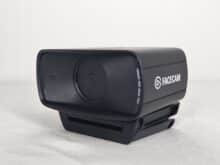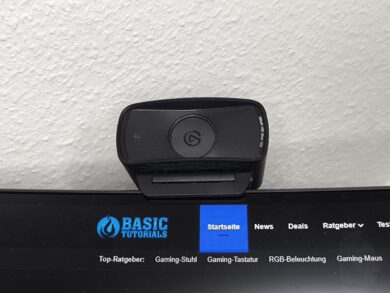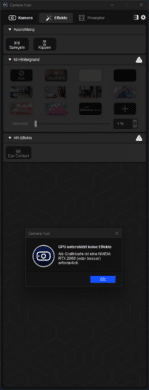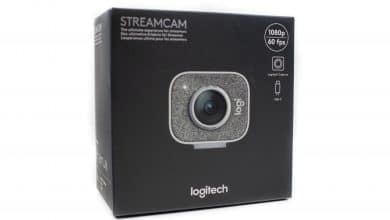
With the Elgato Facecam MK.2, the well-known Corsair subsidiary is expanding its portfolio with an optimized version of the previous Facecam. The Facecam MK.2 is primarily aimed at content creators and, in addition to an unchanged price, is set to offer a more modern feature set. Our test below reveals whether the Full HD webcam is worthwhile in practice and what the new features are all about.
Technical data
| Model | Facecam MK.2 |
| Dimensions (without bracket, HxWxD) | 38 x 84 x 61 mm |
| Weight (without holder) | 90 g |
| Weight (incl. holder) | 136 g |
| Connection | USB type C, USB 3.0 |
| Max. Video resolution | 1080p/60 frames per second |
| Supported resolutions | 1080p60, 1080p30, 720p120, 720p60, 720p30, 540p120, 540p60, 540p30 |
| Lens | Elgato Prime Lens f/2.4 – Focal length: 24 mm Field of view: 84 degrees (diagonal) |
| Focus range | 30 cm – 120 cm |
| Software | Elgato Camera Hub |
| Compatibility | windows 10 (64-bit) or higher, macOS 12 or higher |
| The price | € 135.13 * |
Scope of delivery
- limited to the essentials
- manufacturer-typical blue packaging
- 2 meter long USB-C cable included
The Elgato Facecam MK.2 typically comes in blue packaging. The front shows the webcam, while the back lists six technical features that set it apart from other webcams. In addition to the Elgato Facecam MK.2 itself, the scope of delivery also includes a 1/4-inch thread with which the webcam can be attached to commercially available tripods. The connection to the computer is made via a 2 meter long USB-C to USB-A cable. Of course, the usual paperwork is also included. Elgato limits itself to a quick start guide and safety instructions.
Appearance & processing
- Prime lens includes an anti-reflective coating
- smooth-running shutter flap for opening and closing
- stable mounting on the monitor or table possible
The Elgato Facecam MK.2 makes quite an impression visually and looks quite bulky due to its size. Compared to the previous model, the height has been reduced by around one centimeter, while the width and depth have only been marginally changed. The front of the Elgato Facecam MK.2 has a proprietary, inwardly curved prime lens with anti-reflective coating and a blue status LED next to the lens. To protect privacy, there is a smooth-running shutter flap that can be slid from left to right in front of the lens. The Elgato Prime lens has an f/2.4 aperture with a focal length of 24 mm and uses a 1/2.5″ Sony STARVIS CMOS sensor for image capture. The latter produces an attractive overall image with natural colors even in less well-lit environments. In addition, a new image signal processor is used, which enables videos with a high dynamic range.
The webcam has a USB-C port on the back, which also functions as a power supply and data transfer to the PC. There are also some elongated slots on this side for ventilation. In terms of workmanship, the Elgato Facecam MK.2 definitely looks high-quality and robust. The improved monitor mount on the underside is also solidly built and can be conveniently and stably mounted on any screen. If required, the mount can be removed for panning and tilting via a twist lock.
Commissioning
- Plug-and-play principle, so no separate driver required
- Elgato Camera Hub should still be used
- a separate microphone is not available
Thanks to the plug-and-play principle, the Elgato Facecam MK.2 is quickly ready for use and only requires a free USB port on the PC. A separate driver is not required to download for the webcam. USB 3.0 is required for optimum functionality. Alternatively, the camera is also compatible with USB 2.0, but then only supports the MJPEG video codec.
To optimize the image quality and make any fine adjustments according to personal taste, we recommend downloading the manufacturer’s own Elgato Camera Hub application. However, the additional software does not need to be actively used, as all image settings are saved in the integrated flash memory of the Elgato Facecam MK.2 at the touch of a button. This means that lost settings are a thing of the past. If you also have the manufacturer’s Stream Deck, you can adjust any Facecam MK.2 settings in real time using buttons or rotary controls.
With its groove-like front, the Elgato Facecam MK.2 fits perfectly and elegantly into the gaming setup. When inactive, however, it tends to remain in the background in the form of a box. Opening the shutter reveals the large lens with a focus range of between 30 and 120 cm. The blue status LED lights up brightly enough, albeit discreetly, and signals that the camera is in active use. The Elgato Facecam MK.2 does not have a microphone, which is why a separate input device must be available for audio recording. In addition, the use of Windows Hello is not possible due to the lack of an infrared sensor.
Image quality
- smooth Full HD resolution at 60 FPS
- standard color-coordinated picture quality, albeit with somewhat reduced saturation
- slight image noise possible with suboptimal illumination in the room
With a Full HD resolution and 60 frames per second, the Elgato Facecam MK.2 offers the same quality as its predecessor in terms of the level of detail in the image. However, if the recording quality is minimized to 720p, a strong 120 frames per second are even possible as a slow-motion effect. If you compare the field of view of the two Elgato Facecams, this has increased by 2 degrees to an impressive 84 degrees with the new camera. The built-in wide-angle lens is particularly advantageous for streamers who want to show more of their own room, which often appears closer to the viewer. The HDR feature is a new addition, allowing the camera to deliver a detailed overall picture even in difficult contrast conditions, be it bright office windows or bright LEDs in the background. The Elgato Facecam MK.2 saves recordings completely uncompressed and with ultra-low latency, which should increase the level of detail and color quality. However, it is a bit of a shame that the webcam still has no autofocus.
In the practical test, the Elgato Facecam MK.2 shows a solid image even in the standard settings without Camera Hub software. The built-in Sony sensor captures the colors and details almost evenly across several test scenes, but this seems to be accompanied by minimally reduced saturation. However, the Elgato Facecam MK.2 is ideal for jumpy streamers, as all movements are always reproduced very smoothly. The automatic white balance is remarkable, as it is able to consistently set the scene well even with frequent changes in light. On the other hand, it is noticeable that there is a slight amount of image noise despite the HDR being activated. This can only be counteracted via the Camera Hub by using the new noise reduction algorithm, which immediately results in a clearer image.
In conclusion, the Elgato Facecam MK.2 delivers good, if not spectacular, image quality. The software offers many controls and settings to improve the image quality, especially the image noise. It is recommended to activate the Dynamic Range function in order to display the colors more vividly. As is usual in the streaming sector, additional lighting next to the Facecam MK.2 would also be an advantage here in order to stand out sufficiently from the background.
Software connection
- many options for improving image quality and configuring to your own taste
- certain effects only possible with NVIDIA graphics cards due to NVIDIA broadcast technology
- no options available for streaming via the software
The camera functions at a glance
As mentioned above, the Elgato Facecam MK.2 should preferably be used in conjunction with the Elgato Camera Hub software . In addition to providing firmware updates, the application also enables the fine-tuning of separate camera functions, as is already familiar in the environment of a DSLR camera. In addition to controls for exposure, white balance and correction of contrast, sharpness or saturation, you can also restrict the recording area of the Facecam MK.2 in the form of a frame. If you want to go even deeper into the matter, you even have the option of overriding the ISO value or configuring the shutter speed. In my personal opinion, the automatic white balance and exposure with a fixed ISO value already work very well. Activating noise reduction and selecting 60 Hz as a flicker filter also significantly improves the image quality.
AI effects for Team Green
The preset function is ideal for streamers who want to switch between several recording areas. Up to four different formats can be saved here and called up at the touch of a button. The face tracking feature is also interesting, as the camera continuously zooms in close to the head at this point. Elgato offers numerous AI effects in a separate effects tab, ranging from blurring to the complete replacement of the background. Such functions are mainly known from Discord or Microsoft Teams. Eye correction is also possible, so that the streamer looks into the camera by default.
However, as all effects are based on NVIDIA broadcast technology within Elgato Camera Hub, they are practically unusable for streamers with an AMD graphics card. This may well prove to be a disadvantage for some users, as this requirement significantly limits the scope of the software. We were also left behind in this area with our AMD Radeon RX 7900XTX. It would therefore be desirable for AMD users to receive equivalent functions via a software update.
Streaming without additional software?
The integration of streaming options directly into Elgato’s own software would also be welcome. After all, the Camera Hub can currently only be used to take screenshots. The use of third-party software such as OBS, Streamlabs or XSplit is therefore indispensable for streamers. It is also worth mentioning that the software was occasionally unable to establish a connection to the Elgato Facecam MK.2 in the test. Restarting the computer did not help here, but only reconnecting the streaming webcam via USB led to the desired success.
Conclusion
The Elgato Facecam MK.2 offers some technical improvements over the previous version and can conjure up higher-contrast images than before on the PC with the new HDR option. The image quality is still good with Full HD resolution at 60 frames per second and the processing of the streaming camera is also at a very high level. This makes the Elgato Facecam MK.2 ideal for streaming or video conferencing within your own four walls, provided you are comfortable with the manufacturer’s own software.
The Elgato Camera Hub is clearly structured and offers numerous features to optimize image quality. In particular, activating noise reduction reduces image noise to a minimum at the touch of a button. Nevertheless, it is more than a pity that the full range of functions can only be used with NVIDIA graphics cards (RTX 2060 or better). Blurring or replacing the background or eye tracking in particular are simply not usable for users with AMD graphics cards. Logitech actually manages this better with its capture software.
To summarize, the Elgato Facecam MK.2 is a rock-solid streaming camera for content creators who want to rely on third-party software for streaming. However, as the Facecam MK.2 is in the higher price range, it is difficult to overlook the current state of the software. In view of the fact that the camera market is now oversaturated and the Elgato Facecam MK.2 has no special features that make it stand out from other cameras, the decision to buy is not easy.
Elgato Facecam MK.2
Workmanship
Features
Image quality
Software
Value for money
83/100
Solid webcam for content creators who value consistent image quality. However, the Elgato Facecam MK.2 is still in the upper price segment, which is unfortunately not reflected in the software scope.




























